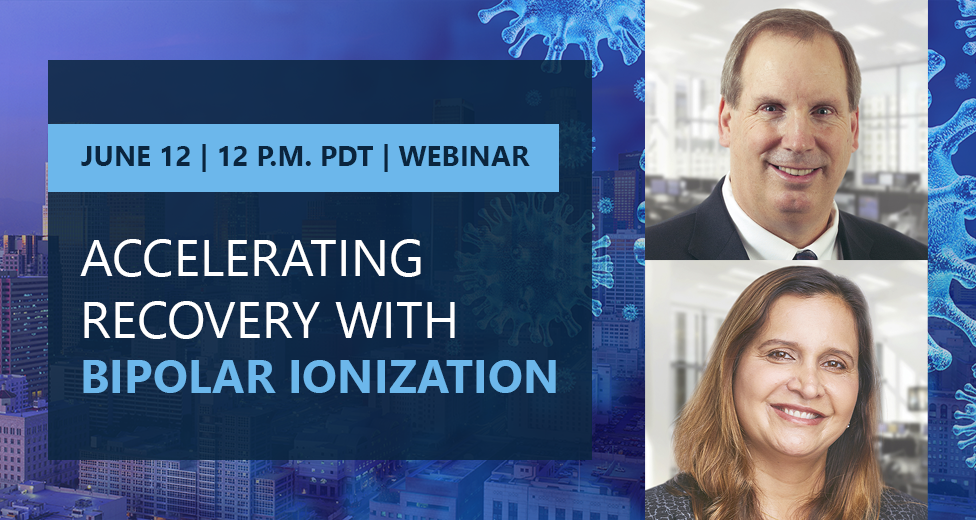
- This event has passed.
Webinar: Bipolar Ionization
June 12, 2020 @ 12:00 pm - 1:00 pm PDT

Webinar: Accelerating Recovery with Bipolar Ionization
Learning Units: 1LU | Free
REGISTER HERE
While the COVID-19 virus will dictate when we head back to offices, schools, convention centers, and other places of commerce, the time to prepare is now. The shift back to business will come with a host of challenges—perhaps one of the most significant being human anxieties as society emerges from isolation and enters a world where the coronavirus will remain prevalent. Places where we once worked, lived, attended classes, and enjoyed leisure activities in comfort may bring unease after weeks or months of social distancing. The new normal will require the development of new protocols and the adoption of game-changing technologies. What if we could help speed up COVID-19 recovery efforts by reducing the anxieties of faculty and students upon their return to campus, employees as they prepare to reenter office spaces, or production workers as they head back to manufacturing facilities? There’s a lesser-known ventilation product called bipolar ionization that can significantly enhance the indoor environmental quality to tackle those fears head-on. Bipolar ionization uses ionization tubes in an existing HVAC system to neutralize contaminants at their source to purify the air, negatively affect bacteria and viruses, eliminate odors, reduce dust and mold particles, and break down toxic compounds and gases.
As we now prepare to shift to life in a post-pandemic world, now is the time to take measures to increase comfort and safety for the eventual return to the workplace. Join this educational session about bipolar ionization and how it can prepare your HVAC system for the battle against COVID-19 and other viruses.
Learning Objectives
- Understand the science behind bipolar ionization.
- Discover bipolar ionization’s impact on viruses, bacteria, and odors.
- Explore the priority building types for bipolar ionization application.
- Describe the five steps to implementing bipolar ionization in an existing HVAC system.
![]()
Robert Weidner, PE, LEED AP, CxA
Bob serves as a principal project manager for Gannett Fleming and specializes in resolving complex mechanical challenges for a diverse range of client organizations. As mechanical practice leader, he emphasizes high-quality deliverables and champions new technologies to move client organizations forward, enable financial savings, and increase sustainability. With more than 37 years of experience in the building industry, Bob is actively involved with ASHRAE, where he serves as the Research Committee Chair and as a member of the TC 9.10 Laboratory Systems committee. He holds a BAE in Architectural Engineering from The Pennsylvania State University.
![]()
Rebecca Hattarki AIA, LEED AP BD+C
In her role as vice president and West Region Facilities Business Line leader, Rebecca oversees the business strategy and planning, project delivery, and operational growth of Gannett Fleming’s facilities practice across the western U.S. With more than 25 years of experience in project management, construction management, and integrated facilities management she uses her innovative and adaptive problem-solving skills to lead and develop multidiscipline, high performing facilities, engineering, and maintenance teams for client organizations. She holds a Bachelor of Arts in environmental design from Texas A&M University and is a registered architect in Texas and California.
REGISTER HERE








